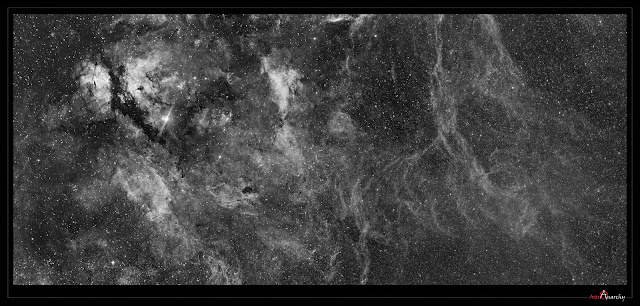COPYRIGHT, PLEASE NOTE
All the material on this website is copyrighted to J-P Metsavainio, if not otherwise stated. Any content on this website may not be reproduced without the author’s permission.
BUY A MUSEUM QUALITY POSTER
BUY A POSTER:https://astroanarchy.zenfolio.com/
Friday, November 18, 2011
Butterfly to Crescent, a new Cygnus project started
A two panel mosaic from the Hydrogen alpha emission.
NOTE. the "Noise" in the background is not a noise but a countless amount of stars!
NOTE. the "Noise" in the background is not a noise but a countless amount of stars!
Last night I was able to shoot two panels in H-a for a new imaging project from Cygnus. At upper left the Butterfly nebula and in middle, the Crescent Nebula.
Clouds rolled in before I was able to shoot any other channels, so colors will follow later.
Canon EF 200 mm at f1.8 is an extreme fast lens to collect photons, only one hour of ten minute subs per panel was needed for good signal to noise.
A closeup to show the resolution.

A gray scale two panel mosaic with my previous project.
I just noticed, that this new panorama and my previous project, Cirrus of Cygnus, are overlapping!
I hadn't purpose to build a large mosaic but since they are overlapping, in some parts, I will make one.
QHY9 camera is a very good match with wider field camera lenses due the smallish, 5,4 microns, pixel size.
Nowadays I', processing all under sampled images, like one above, up-scaled 200% to maintain the smallest possible details. It needs a lots of memory and the processing gpower though! A single, up-scaled gray scale FIT-format, image will take about 500 meg to handle (32bit floating point), usually there are more than a dozen of them...

A gray scale two panel mosaic with my previous project.
Technical details:
Processing work flow:
Image acquisition, MaxiDL v5.07.
Stacked and calibrated in CCDStack2.
Deconvolution with a CCDStack2 Positive Constraint, 33 iterations, added at 40% weight
Levels, curves and color combine in PS CS3.
Optics, Canon EF 200mm camera lens at f1.8
Camera, QHY9
Image Scale, ~5 arcseconds/pixel
Guiding, Meade LX200 GPS 12" and a Lodestar guider
Filter, Baader 7nm H-alpha
Exposures for two panels,
Panel 1, 6x600s Binned 1x1
Panel 2, 6x600s Binned 1x1
Thursday, November 17, 2011
Cirrus of Cygnus as a stereo pair 3D
Parallel vision 3D
Cross vision 3d
Other 3D-formats:
Original 2D:
NOTE! This is a personal vision about forms and shapes, based on some known facts and an artistic impression.
Labels:
stereo images
Cirrus of Cygnus as an anaglyph Red/Cyan 3d
You'll need Red/Cyan Eyeglasses to be able to see images as 3D.If you have a Red and Blue filters, you can use them! Red goes to Left eye.
Other 3D-formats:
Original 2D:
NOTE! This is a personal vision about forms and shapes, based on some known facts and an artistic impression.
Labels:
anaglyph images and movies
Tuesday, November 15, 2011
NGC 7000, North America & Pelican Nebulae
North America and Pelican Nebulae area
R=Sulfur, G=Hydrogen and B=Oxygen. Note, the "noise" in background is not a noise but countless stars!
A cropped closeup to show the resolution. After countless tweaks, stars are now pinpoints from edge to edge, this lens is very sharp full open at f1.8 but focusing is more than difficult... the critrical focus zone is about 7 microns, 7/1000mm!
A cropped closeup to show the resolution. After countless tweaks, stars are now pinpoints from edge to edge, this lens is very sharp full open at f1.8 but focusing is more than difficult... the critrical focus zone is about 7 microns, 7/1000mm!
Canon EF 200mm f1.8 is a monster lens (fastest tele lens in the world). Total exposure time for all channels is just 4h 30min for this relative deep narrow band image, shot under a heavy light pollution.
As can be seen from the image, North America and Pelican Nebulae are actually a single emission area, divided visually to two parts by a dark nebula at front.
I have shot a narrower wide field shot from lower part of this formation, earlier in this Autumn, with a Tokina AT-X 300mm f2.8 camera lens, it can be seen HERE. Area is from just bellow the North America Nebula.
R=Hydrogen + Sulfur, G=Oxygen and B=Oxygen + Hydrogen.
This palette is very close to a visual spectrum.
An animated image, with and without stars
Technical details:
Processing work flow:
Image acquisition, MaxiDL v5.07.
Stacked and calibrated in CCDStack2.
Deconvolution with a CCDStack2 Positive Constraint, 33 iterations, added at 50% weight
Levels, curves and color combine in PS CS3.
Optics, Canon EF 200mm camera lens at f1.8
Camera, QHY9
Guiding, Meade LX200 GPS 12" and a Lodestar guider
Image Scale, ~5 arcseconds/pixel
H-alpha 15x600s, Binned 1x1
O-III 6x600s, Binned 1x1
S-II 6x600s, Binned 1x1
Ps.
There is a tiny nebula in lower Right crner, near the "Pelican's head", if somebody knows, what it is, please leave a comment here.
It emits strongest at H-a but there are O-III and S-II bands visible too.
Update.
A friendly Blog follower just posted a comment about this nebula.
It's an emission nebula designated as a GN 20.43.9, thank you.
There is a tiny nebula in lower Right crner, near the "Pelican's head", if somebody knows, what it is, please leave a comment here.
It emits strongest at H-a but there are O-III and S-II bands visible too.
Update.
A friendly Blog follower just posted a comment about this nebula.
It's an emission nebula designated as a GN 20.43.9, thank you.
Subscribe to:
Comments (Atom)



















